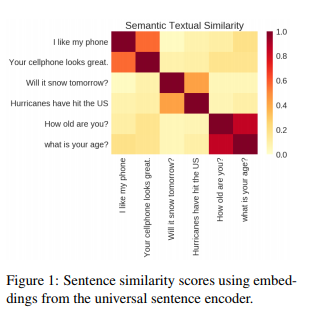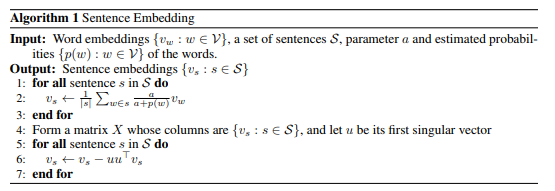

Cer et al. Universal Sentence Encoder
Simplest sentence embedding technique is to average individual word embeddings, and widely used. Limitation is that there is (practically) only a finite number of words in natural languages, so that the additional dimensions will not be used to store additional information, beyond a certain threshold
Previous works have computed phrase or sentence embeddings by composing word embeddings using operations on vectors and matrices e.g.,(Mitchell & Lapata, 2008; 2010; Blacoe & Lapata, 2012). They found that coordinate-wise multiplication of the vectors performed very well among the binary operations studied.
Unweighted averaging is also found to do well in representing short phrases (Mikolov et al., 2013a)
Another approach is recursive neural networks (RNNs) defined on the parse tree, trained with supervision (Socheret al., 2011) or without (Socher et al., 2014).
the skip-gram model (Mikolov et al.,2013) is extended to incorporate a latent vector for the sequence, or to treat the sequences rather than the word as basic units.
Skip-thought of (Kiros et al., 2015) tries to reconstruct the surrounding sentences from surrounded one and treats the hidden parameters as their vector representations. The model consists of an RNN-based encoder-decoder. One interesting insight in the Skip-Thought paper was a vocabulary expansion scheme: Kiros et al. handled words not seen during training by learning a linear transformation between their RNN word embedding space and a larger word embedding such as word2vec.
Other neural network structures include convolution neural networks, such as (Blunsom et al., 2014) that uses a dynamic pooling to handle input sentences of varying length and do well in sentiment prediction and classification tasks.
Zhang et al. demonstrated simple cocatenation of word embeddings produced good results in 2016
Arora from Princeton University published a relatively simple method
just compute the weighted average of the word vectors in the sentence and then remove the projections of the average vectors on their first singular vector (“common component removal”).
Smooth inverse frequency (SIF) Weight of a word is where is the parameter, and is the estimated word frequency.
SIF is highhly reminiscent of TF-IDF reweighting (Sparck Jones, 1972; Robertson, 2004) if one treats a “sentence” as a “document” and make the reasonable assumption that the sentence doesn’t typically contain repeated words. Such reweightings are a good rule of thumb but has not had theoretical justification in a word embedding setting.

More recently (2018), Ruckle proposed of a strong Bag of Word baseline is the concatenated p-mean embeddings.
Quick-thoughts vectors are a recent development of the Skip-thoughts vectors by Logeswaran (2018)
MGNC-CNN: A simple approach to exploiting multiple word embeddings for sentence classification. Arola et al., (2017) A Simple but Tough-to-Beat Baseline for Sentence Embeddings Ruckle et al., (2018) Concatenated Power Mean Word Embeddings as Universal Cross-Lingual Sentence Representations Logeswaran et al., (2018) An efficient framework for learning sentence representations